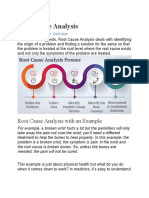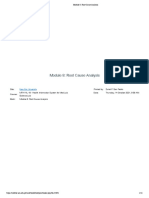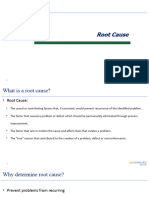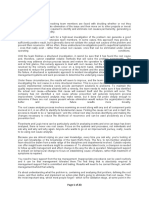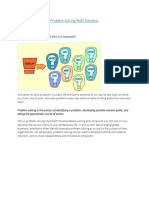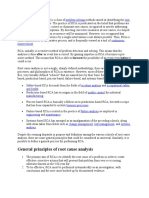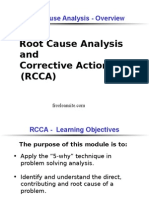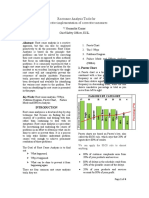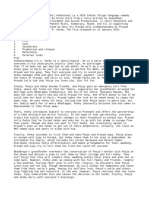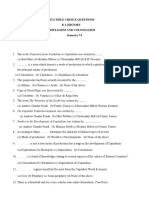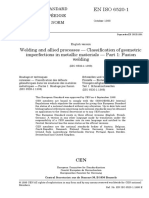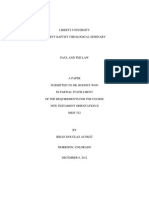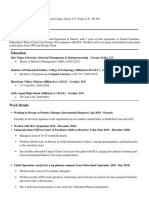Guide to Root
Cause Analysis
By Brian Newbery
1
�Introduction
Every medical device company is going to occasionally run into issues that require some level of
internal investigation and where a thorough root cause analysis should be performed.
This could be during the design and development phase, or due to a production nonconformance,
a CAPA, or an audit finding. In all cases, a failure investigation and root cause analysis
investigation need to be carried out to determine exactly why the issue occurred. Once that is
known, the appropriate action can be taken to prevent a recurrence.
Unfortunately, it has been known that bias and guessing the root cause lead to corrective actions
being ineffective and resulting in the problem recurring.
An investigation should be a great opportunity to learn the true root cause of the issue and gain
valuable insights that drive process and product improvements, resulting in higher quality and safer
medical devices.
In this article, I cover the overall top-level process for conducting a root cause analysis and 5 of the
most common methods used.
The diagram below shows the basic steps for a nonconformance investigation
and a root cause analysis.
Determine
Create a Determine Verify if
Factors Identify the
Problem Corrective Action is
Leading to Root Cause
Statement Action Effective
Problem
What is Root Cause Analysis?
So let’s start with what exactly is root cause analysis, and how it should be conducted to achieve
the best result in determining the actual root cause. A root cause is defined as a factor that caused
a nonconformance and should be permanently eliminated through process improvement.
The root cause is the core issue—the highest-level cause—that sets in motion the entire cause-
and-effect reaction that ultimately leads to the problem(s). Root cause analysis is defined as a
collective term that describes a wide range of methods used to uncover causes of problems.
2
�Some of these approaches are geared more toward identifying true root causes than others, some
are more general problem-solving techniques, and others simply offer support for the core activity
of root cause analysis. As already mentioned, but worth repeating, root cause analysis is an
essential early part of investigating for CAPA’s as well as, where applicable, customer complaints,
nonconformances, and audits.
ISO 13485:2016 8.5.2 Corrective action states that: The organization shall take action to eliminate
the cause of nonconformities to prevent recurrence.
Also included under 8.5.2 is a requirement for the organization to document a procedure which
includes determining the causes of nonconformities.
Best Practice for Conducting a Root Cause Analysis
Right after the appropriate priority steps have been taken to contain and control the issue at hand,
and it’s time to start the process of corrective and preventive actions, the next critical step is to
determine the root cause of the issue, why it occurred and finally how to take action to prevent a
recurrence.
While it is true in some cases it may be possible for one experienced individual to conduct such a
formal root cause analysis, in my experience, it is almost always best practice to first form a team
of stakeholders and those directly involved in the responsible processes
Here are the recommended steps for a successful root cause analysis:
1. Form a team: appoint a team leader/facilitator/record keeper.
2. Create a problem statement: use brainstorming and, based on data and evidence on the
issue, create a clear and concise problem statement that describes the problem and impact.
3. Determine factors that caused the issue: using direct knowledge of the team members
and/or gathering information as required.
4. Identify the root cause: keep digging until you finally uncover and agree on the true root
cause of the problem as stated.
5. Determine the appropriate corrective actions: now that you have identified the cause,
follow the corrective action procedure to eliminate the problem. Follow your normal CAPA
procedures including communication, verification and validation as well as documentation of
all steps including the root cause analysis.
6. Review and evaluate the effectiveness of the corrective actions. As per the required
CAPA procedure, make sure you determine the effectiveness of the corrective actions and
make additional improvements as necessary.
3
�Methods used for Root Cause Analysis
Several methods can be used for identifying the real root cause of an issue and developing the
appropriate corrective actions to prevent it from recurring. Here are 5 of the most commonly used
methods:
1. “5 Whys” Root Cause Analysis;
2. Cause and Effect Analysis (Fishbone/Ishikawa Diagram);
3. Fault Tree Analysis;
4. Pareto Chart;
5. Failure Modes and Effects Analysis (FMEA).
There are certainly other methods that can be used, including 8D Problem Solving, DMAIC, and
Scatter Diagrams.
The root cause analysis process involves data collection, team brainstorming, analysis, and root
cause identification. Once that’s done, the corrective action process can proceed.
Root cause analysis is an essential process to determine the right corrective actions to take to
resolve a problem. By itself, it does not solve the problem but points the direction to take and the
root cause to focus on.
Making effective corrective active actions based on the root cause analysis will provide the results.
4
�“5 Whys” Root Cause Analysis
In the 5 Whys analysis keep asking “Why” up to 5 times and until the root cause of the problem is
uncovered. Form a team of stakeholders who are familiar with the issue and brainstorm the why
did this occur, using data and evidence. Use confirmation methods where applicable. Once the
root cause is determined the corrective action process can begin.
Problem Description:
h
Why did this occur (1) Confirmation (method)
Yes
Response 1 No
Response 1
h
Why did this occur (2)
Response 2 Yes
Response 1
No
h
Why did this occur (3)
Response 3 Yes
Response 1
No
h
Why did this occur (4)
Response 4 Yes
Response 1
No
h
Why did this occur (5)
Response 5 Yes
Response 1
No
Root Cause:
5
�Cause and Effect Analysis (Fishbone/Ishikawa Diagram)
Start the use of a Fishbone Diagram by entering the problem statement on the right of the diagram.
Then the team can brainstorm under the major categories (6 M’s) the causes of the problem and
enter as branches from the main arrow leading to the problem statement.
Subbranches from each main cause will be further “whys” and causes that made it happen. Some
of the main categories will most likely have more causes, but also the team should focus on those
areas with few or no causes, just to make sure all areas are covered.
Measurement Materials Methods
Problem
Mother Nature Manpower Machines
(Environment)
6
�Fault Tree Analysis
Fault Tree Analysis is a graphical tool used to explore the causes of a problem.
It starts with the problem statement at the top and then adds a series of lower-level events. It is a
top-down approach to identify the lower-level failures (basic events) that cause the system-level
failures (top events).
Fault tree analysis consists of “events” and “logic gates,” which connect the events to identify the
cause of the top undesired event.
Fault Tree Example:
7
�Pareto Chart
Pareto charts are a great, simple tool to show frequency in highest order or frequency first. A
Pareto chart is a bar graph. The lengths of the bars represent frequency or cost (time or money),
and are arranged with longest bars on the left and the shortest to the right. In this way the chart
visually depicts which situations are more significant.
Bar charts can be used for the following:
• When analyzing data about the frequency of problems or causes in a process
• When there are many problems or causes and you want to focus on the most significant
• When analyzing broad causes by looking at their specific components
• When communicating with others about your data
The Pareto Chart helps to select the major issues to work on.
Pareto Chart Example
20
Qty Defect
15
10
8
5
3
Defect 1 2 3 4 5 6
8
�Failure Modes and Effects Analysis (FMEA)
Failure Modes and Effects Analysis (FMEA), either for design (DFMEA) or process (PFMEA), is a
systematic method for evaluating a design or process. It can be used as one of the methods for
finding a potential root cause assuming a failure has already occurred, and the team is trying to
identify potential causes and severity of the failure mode. Or it can also be used proactively.
This would mean assuming that a particular failure in design or process might occur and taking
action to manage and change the areas identified as possible points of failure.
Final Thoughts
Successful corrective actions frequently use a formal root cause analysis and most likely use
one of the methods covered here. I have come across medical device companies that get a
little lost in the use of the tool itself, or even worse, don’t use any of these methods and jump to
a conclusion as to the cause, and so implement corrective actions that are not effective. Here
are a few tips for making the most out of root cause analysis:
• Choose tools to use and train the team on the basic steps behind each of the tools.
• FMEA is a great tool to use, but it is sometimes overused and not always the best
method for root cause analysis.
• In my experience, the 5 “Whys” and Fishbone Diagram are good methods to start with.
• In almost all cases, use a cross-functional team for root cause analysis and include
team members directly involved with the processes where the problem occurred.
9
�Go to our ISO
13485 Store
(link above) for
information on
these products
and for
immediate
donload.
10

